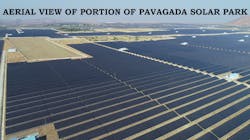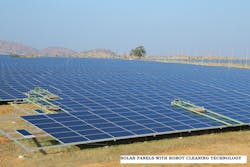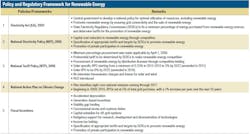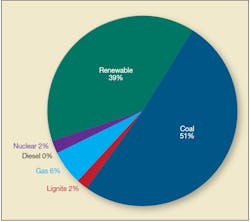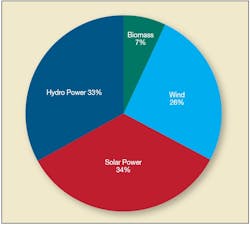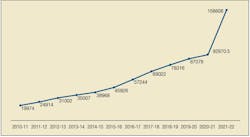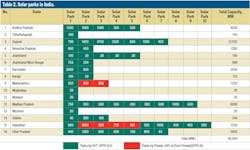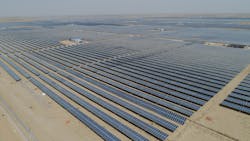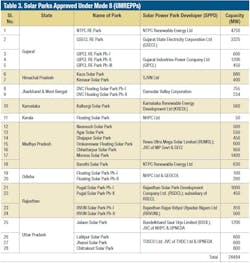India Taps into Renewable Energy Potential
India’s renewable energy opportunities include solar, wind, small hydropower and biopower, among other technologies. The Indian government recognizes harnessing these resources are vital for economic growth and improving the climate. Its Ministry of New & Renewable Energy (MNRE) estimates a renewable energy potential of around 1700 GW from commercially exploitable sources, including about 695 GW from wind at 120 m (394 ft), 211 GW from small hydropower, 45 GW from bioenergy and 750 GW from solar energy (assuming 3% wasteland development). In addition, solar photovoltaic and solar thermal technologies can produce around 35 MW/sq km (13.5 MW/sq mile).
The current trend shows India’s clean energy potential is mostly untapped. To maximize renewable energy efficiency, the government set an aggressive capacity target of 175 GW by 2022, including 100 GW of solar energy. In addition, it set targets of 265 GW by 2024-2025 and 500 GW by 2030, whereby 50% of the country’s electricity generation capacity would come from renewable energy sources.
To help meet these targets, India’s National Infrastructure Pipeline task force aims to provide world-class renewable energy facilities in the country, with the government implementing supporting policies and regulations. This infrastructure is expected to improve the quality of life for all citizens and attract critical infrastructure investments to enable India to become a US$5 trillion economy by 2025.
Power From Renewables
In India, the current total installed capacity from various sources of generation is around 399.49 GW, with renewable energy accounting for around 39.2% of total installed capacity, including large hydropower. The solar market is expanding the fastest, accounting for 33% of total renewable energy installations. Furthermore, the share of renewables has risen from 14% in 2014-2015 to 39.2% in 2021-2022 compared to thermal and other nonrenewable sources.
Provided that land is accessible for ultra-mega solar projects, India has an enormous solar capacity potential of more than 750 GW. Through a vigorous and ambitious National Solar Mission (NSM), launched by the MNRE, and renewable purchase obligation (RPO) compliance, the country is increasing its installed solar power resources. Its 100-GW target for 2022 placed the nation on the global solar list. This target included grid-linked solar power capacity that exceeded more than 53 GW at the end of March 2022, with another 44.27 GW of solar power capacity currently under implementation.
At the end of March 2022, the total renewable installed capacity was 156 MW, 608 MW, including 570 MW of hydropower. India now operates about 39.2% of its installed capacity from renewable energy, bringing it much closer to meeting its commitment.
Since 2015, the country’s renewable energy sector has grown steadily because of the government’s positive policy decisions and availability of markets for both developers and manufacturers. The government is confident it will surpass its 2022 target and, therefore, is on track to meet its goal of 500 GW of renewable energy capacity by 2030.
Policies And Regulations
To boost renewable energy, India has implemented several policies and a regulatory framework. The country’s renewable energy market has developed into a major player in grid-connected power generation capacity over the years. With renewable energy’s increasing importance in the energy planning phase, it is being seen as one of the critical ways for the country to fulfill its goal of energy sustainability.
Over the last few years, the government has taken several measures, including rolling out solar parks, hosting an annual RE-Invest meeting and expo for global investors and launching a massive grid-connected rooftop solar program for a Green Energy Corridor, Schemes of Farmers. It also launched the Surya Mitra training program, a waiver of interstate transmission charges and losses for solar and wind power, mandatory procurement of 100% power from waste-to-power projects, and renewable generation obligations on new thermal and lignite plants.
The government of India has been driving a renewable energy program to achieve energy security, increase energy access and reduce the carbon footprint of the national economy. This in in line with India’s commitments under the 2015 Paris Agreement. The prime minister announced at the COP26 Summit in Glasgow that India plans to reach non-fossil fuel energy capacity of 500 GW and meet 50% of its energy requirements from renewable energy by 2030. Also announced was that India would reduce its total projected carbon emissions by 1 billion tons as well as reduce the carbon output of its ecomony by 2030. By 2070, India projects it will achieve a target of net zero.
These noteworthy programs also include the promotion of concerted research and development efforts in solar photovoltaics (PV), thermal and second-generation biofuels, hydrogen oil and fuel cells, among others.
MNRE’s Efforts
India is a tropical region where sunlight is present daily for long hours and in great intensity. MNRE launched the NSM in January 2010 to establish India as a global leader in solar energy. The NSM set policy conditions to encourage rapid adoption of solar power. It proved necessary to building state-level infrastructure solely committed to supporting solar power generation, to effectively tap solar energy resources and achieve the goals of the NSM. One way was to concentrate on the construction of solar parks. The estimated target of 100 GW for solar power capacity by 2022 will consist of 40 GW of rooftop solar projects and 60 GW of medium- and large-scale solar projects.
Several new large-scale projects have been launched, including the world’s largest single-location solar plant of 7500 MW in Leh Kargil, a 12,000-MW plant for public-sector solar projects, and a 40,000 MW solar park. The government’s initiatives also include a 200 MW solar and wind hybrid park in Andhra Pradesh, a 150-MW floating solar park in Jharkhand, a 300 MW floating solar park in Odisha, a 989 MW floating solar park in Jharkhand/West Bengal, and a 600-MW floating project in Madhya Pradesh.
Recently, the idea of round-the-clock renewable energy has gained traction as a means of providing firm electricity supplies to the electric distribution utilities.
Solar plants established under the state scheme often are chosen through a tariff-based open bidding and reverse auction mechanism of solar projects under NSM.
This method of selection has reduced the average bid tariff for solar in bidding and auctions from 17.91 rupees/kWh in December 2010 to about 1.99 rupees/kWh in December 2020.
In accordance with its Green Energy Corridor project, MNRE also is supporting the creation of an interstate transmission system, which will transmit more than 20 GW of power from renewable energy generation stations to load centers. To finance this transmission system, the Power Grid Corp. of India Ltd. (PGCIL) has sought a loan of US$1 billion from the Asian Development Bank (ADB), comprising a sovereign guaranteed loan of US$500 million and a non-sovereign loan of US$500 million.
MNRE, together with the SERCs of the State Union territories, review notifications on net metering and feed-in tariffs to promote rooftop solar plants. To achieve the 40-GW goal for rooftop grid-connected solar projects, the net metering program has been implemented in most of the states.
Together with the private sector, all major industries are being pursued, including railways, airports, hospitals, educational institutions and both federal and state government buildings. MNRE, the Indian Space Research Organization and the Visualization of Earth Observation Data and Archival System (VEDAS) portal have collaborated to geotag all solar rooftop installations and future construction plans will include a rooftop rental policy.
Key Milestones
India’s renewable sector has hit several key milestones to date, including but not limited to:
1. Decentralized renewable power generation for rural electrification — A country’s growth is primarily determined by its energy use, as it is critical to a country’s economic development. As a result, the Indian government aspires to provide all citizens with secure, accessible and clean power 24 hours a day, seven days a week. Where there is an insufficient source of electricity or the grid cannot access a location, microgrids are used. Private players build microgrids, which support a population of villages by connecting homes, schools, hospitals, agricultural fields and even telecommunications towers, generating a steady stream of revenue for the developers.
2. Solar parks — Although solar power plants can be built anywhere in the country, this could result in a scattering of projects, raising the cost per megawatt of the plant and increasing technological losses. Therefore, the country’s solar power is primarily made up of utility-scale grid-connected capacity and ultra-mega solar parks.
Mega solar power projects are planned to have an installed capacity of more than 500 MW. However, smaller parks can be considered in hilly states as well as states where there is an acute shortage of nonagricultural land. The capacity of the solar park scheme approved by the Indian government is 40 GW, of which the 40 GW has been approved in 16 states across 61 solar parks of differing capacities and at different stages of development.
The world’s largest known solar park in terms of capacity is 2000 MW in the state of Karnataka developed under the government of India’s solar park scheme. The uniqueness in land acquisition for the Pavagada solar park in Karnataka is that the 13,000 acres (5261 hectares) is privately owned and leased for a period of 28 years. This is the first known solar park in the world where the land remains vested with landowners. The Pavagada solar park was commissioned in different phases and is now fully operational, with the 2000-MW capacity supplying power to the state transmission system.
3. Wind-solar hybrid systems — MNRE published the national wind-solar hybrid policy to encourage the development of new hybrid projects as well as the hybridization of existing wind-solar projects. The strategy seeks to boost grid reliability by reducing fluctuations in renewable energy production.
4. The Pradhan Mantri-Kisan Urja Suraksha Evam Utthaan Mahaabhiyan (PM-KUSUM) scheme — The PM-KUSUM solar pump distribution system was included in the 2018-2019 budget to provide farmers with relief from high-cost diesel-run water pump sets and intermittent power supplies. In areas where the grid is not accessible, approximately 1.75 million solar pumps will be installed. This scheme aims to subsidize 30% of the energy costs and the state will issue a loan for a similar percentage.
5. Indian Renewable Energy Development Agency (IREDA) — IREDA has introduced several new schemes to enhance credit flow in the renewable energy sector.
6. Launch of Hydrogen Mission and notification of Green Hydrogen Consumption Obligation (GHCO) — Launch green hydrogen projects and establish public-private partnership framework for R&D.
Targets On Track
Energy initiatives and policies are positioning India to meet and even exceed its 175-GW target of renewable energy by 2022:
1. Ultra-mega renewable energy power parks (UMREPPs) — The Indian government recently introduced this new way of implementing solar parks as a subset of the solar park scheme.
2. Interstate system for renewable energy zones — MNRE formed a committee to identify potential wind and solar energy zones in the country to achieve the target of 175 GW by 2022. It identified a total of 66.5 GW renewable energy zones (REZ), including 50 GW of solar and 16.5 GW of wind in seven states, and further developed a comprehensive transmission scheme integrating these zones.
3. One sun, one world, one grid (OSOWOG) — During the inaugural function of the second global RE-Invest meeting, at the first assembly of the International Solar Alliance, the Prime Minister of India called for connecting solar energy supply across borders: “We have a dream of one sun, one world, one grid. We generate round-the-clock electricity from the sun as it sets in one part of the world but rises in another part. The sun never sets for the entire Earth.”
To help deliver the vision of OSOWOG, it was resolved ot combine efforts and create a more interconnected global grid. This will help in building long-distance cross-border transmsision lines to connect renewable energy generation and demand centers across continents. India already has experience with transmission system interconnections with neighboring countries like Bangladesh, Nepal, Bhutan and Sri Lanka (where discussions are ongoing) for effective utilization of regional energy resources that can be well leveraged and scaled up to achieve the OSOWOG outcomes. Mutual cross-border cooperation among neighboring nations will lead to prosperity and strengthening energy security in the region.
The Way Forward
India has and continues to suffer from COVID-19’s crippling consequences, posing health, economic and social problems. The provision of reliable power and resilience of the energy industry has become essential. The country needs to increase its capacity for supply management, enhance its grid stability and combine power hardware and software to combat future energy security threats. There is an intense need for a more comprehensive restructuring of the power market, as both private and public investments are vital to the country’s power sector. Crucial power sector changes will require greater cooperation at the global, regional and state levels. Due to the pandemic, demand for renewable eneryg has been sluggish, financial conditions of utilities, and an increase in prices of materials.
The Green Energy Corridor project was launched to create dedicated transmission lines and substations to help bring renewable projects to remote locations. This scheme consists of both intrastate and interstate transmission networks, including a submarine cable interconnection for 1000-MW offshore wind power projects proposed off the coast of Gujarat. GEC scheme involves setting up transmission corridors to transmit renewable energy. It is a distinct scheme because a separate set of transmission lines have been identified to transmit renewable energy projects. All these reforms are supporting the country’s vision of increasing renewable energy sources to 450 GW by 2030.
Acknowledgments
The authors wish to acknowledge the technical support and guidance given by Sunil Kumar Gupta, Aravindh MA, Tarun Saketh, Sachin Meena and Akshay Dalal from the Ministry of New & Renewable Energy, and Poonam Meena in the preparation of this article.
Radhey Shyam Meena ([email protected]) has a post-graduate degree in electrical engineering. He is enrolled in the eMasters degree program in Power Sector Regulation, Economics and Management of the Indian Institute of Technology. Since March 2016, Shyam has been employed by the Ministry of New & Renewable Energy (MNRE), working in the green energy sector. He is actively engaged with several technical institutions, including the IEEE, Institution of Engineering Technology, Renewable Energy Society of India and Solar Energy Society of India.
Dilip Nigam has a post-graduate degree in energy and has worked for the Ministry of New & Renewable Energy for more than 35 years, handling the National Solar Mission, wind and other major renewable energy schemes.
Rohit Bhakhar is employed in the Malaviva National Institute of Technology, where he manages the department of electrical engineering and center of energy. He is actively engaged with numerous technical institutions, including the IEEE.
Dwark Prahladadas Kothari is a former director and head of the Center of Energy Studies at the Indian Institute of Technology. Currently, he works as a professor at the Visvevaraya National Institute of Technology and serves as vice chair of the Renewable Energy Society of India.
Dinesh Birla is a professor in the electrical engineering department of Rajasthan Technical University.
Anindya Sundar Parira is a scientist in the Ministry of New & Renewable Energy and is currently studying for a master’s degree from the Indian Institute
of Technology.
About the Author
Radhey Shyam Meena
Radhey Shyam Meena ([email protected]) has a post-graduate degree in electrical engineering from Rajasthanthan Technical University, Kota, India. He is a chartered engineer who enjoys the challenge of producing sustainable energy transitions. Since March 2016, Shyam has been employed by the Ministry of New & Renewable Energy (MNRE), working in the green energy sector. He is actively engaged with several technical institutions, including the IEEE, Institution of Engineering Technology, Renewable Energy Society of India and Solar Energy Society of India.
Dilip Nigam
Dilip Nigam worked in the private sector before joining the Government of India’s Ministry of New and Renewable Energy in 1987. He spent 16 years working on the country’s wind energy program and the last 14 years involved in the solar energy program. Nigam currently serves as an adviser for the National Solar Mission initiative dealing with schemes to promote solar power development.
Rohit Bhakhar
Rohit Bhakhar is employed in the Malaviva National Institute of Technology, where he manages the department of electrical engineering and center of energy. He is actively engaged with numerous technical institutions, including the IEEE.
Dwark Prahladadas Kothari
Dwark Prahladadas Kothari is a former director and head of the Center of Energy Studies at the Indian Institute of Technology. Currently, he works as a professor at the Visvevaraya National Institute of Technology and serves as vice chair of the Renewable Energy Society of India.
Dinesh Birla
Dinesh Birla is a professor in the electrical engineering department of Rajasthan Technical University.
Anindya Sundar Parira
Anindya Sundar Parira is a scientist in the Ministry of New & Renewable Energy and is currently studying for a master’s degree from the Indian Institute of Technology.

